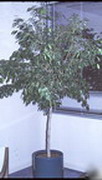|
Don't Let Your Houseplants Be Left in The DarkLight is everything! .Why Does Light Matter? Light is the source of energy that drives a plants metabolism. We all learned, or were supposed to, about photosynthesis in Grade 9 science. We can see that taking a typical tropical plant into our homes from its natural environment, can reduce it's energy supply by over 90%. If we took away 90% of your energy supply, how long would you last? What Hope Is There? The really great news for those of us attempting indoor gardening, is that houseplants are much more adaptable and tolerant than we are. A great number of houseplants will stay alive in the light levels that we can supply and some of them will even thrive. One of the secrets is to understand the origins of the various species that we are attempting to grow. Look At Nature! In the tropics there is an upper canopy of plants that are adapted to those high light levels and few of those species appear on anybody's list of good houseplants. This upper canopy does however block much of that intense light so that the lower story plants are actually adapted to living in greatly reduced light and these are the species that we need to be inviting into our homes and offices. I Just Want A Couple of Nice Plants! The vast majority of indoor gardeners are content, just to keep a few houseplants, to add some warmth and vitality to their decorating scheme. There is also something therapeutic in the regular regimen of watering and care that seems to satisfy a basic human need. Many of these houseplants also have a wonderful ability to clean the air that we breathe. The light required to maintain a collection of interesting and air cleaning houseplants is not difficult to provide. Most plants purchased from a reputable store will come with a care tag telling you about their light requirements. As this site grows we will profile more and more of them as well. The trick is to understand what the tag means when it talks about high light or low light. 
|
 One Foolproof Plant! The trailing Pothos, Epipremnum aureum, is actually a climbing vine whose mature leaves are large divided foliage that is quite unlike the small heart shaped leaves of the juvenile form that we commonly grow. Because they climb up the base of the over story trees they are adapted to the relatively low light levels that penetrate that canopy. That allows them to be classified as low light plants in our homes growing in as little as 50 fc. which is just about anywhere that you could see to read.
One Foolproof Plant! The trailing Pothos, Epipremnum aureum, is actually a climbing vine whose mature leaves are large divided foliage that is quite unlike the small heart shaped leaves of the juvenile form that we commonly grow. Because they climb up the base of the over story trees they are adapted to the relatively low light levels that penetrate that canopy. That allows them to be classified as low light plants in our homes growing in as little as 50 fc. which is just about anywhere that you could see to read. 